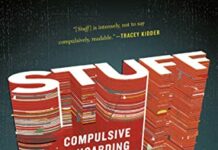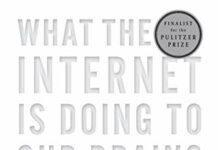
Ebook Info
- Published: 2011
- Number of pages: 581 pages
- Format: Epub
- File Size: 6.20 MB
- Authors: Bill Bryson
Description
In these pages, the beloved Bill Bryson gives us a fascinating history of the modern home, taking us on a room-by-room tour through his own house and using each room to explore the vast history of the domestic artifacts we take for granted. As he takes us through the history of our modern comforts, Bryson demonstrates that whatever happens in the world eventually ends up in our home, in the paint, the pipes, the pillows, and every item of furniture. Bryson has one of the liveliest, most inquisitive minds on the planet, and his sheer prose fluency makes At Home one of the most entertaining books ever written about private life.
User’s Reviews
Editorial Reviews: Review “Delightful. . . . Bryson’s enthusiasm brightens any dull corner. . . . Hand over control and simply enjoy the ride.” –The New York Times Book Review”An exuberant, shared social history. . . . Told with Bryson’s habitual brio. . . . A personal compendium of fascinating facts, suggesting how the history of houses and domesticity has shaped our lives, language, and ideas.” -The New York Review of Books“A treasure trove. . . . Playful, yes, but Bryson is also a deft historian.” –Los Angeles Times“If this book doesn’t supply you with five years’ worth of dinner conversation, you’re not paying attention.” –People“Bryson is fascinated by everything, and his curiosity is infectious. . . . You can take this class in your pajamas—and, judging by the book’s laid-back, comfy tone, I have a sneaking suspicion that Bryson wrote much of it in his.” –New York Times Book Review “The experience of reading a Bill Bryson book is something you don’t want to stop—a pip and a spree and, almost incidentally, a serious education. And never tiresome, for Bryson has the gift of being the student and not the tutor.” –Washington Post “At Home is both insightful and entertaining, leaving a deeper appreciation of the stuff of home life that will never again be viewed as mundane.” –Seattle Times“Readers who enjoyed Mr. Bryson’s apparently inexhaustible supply of nifty facts in such previous books as “A Short History of Nearly Everything” (2004) or “The Mother Tongue” (1991) will be happy to find the author’s pen as nimble and his narrative persona as genial as ever.” –Wall Street Journal “Bryson serves up a rich banquet of utterly fascinating and sometimes horrifying facts of where and how people have slept, eaten, made a living, built homes and monuments, frolicked, traveled, given birth and been laid to rest.” –Bookreporter.com “Its lasting impression is the author’s delightful, boundless curiosity. . . . The best nonfiction illuminates what we found impossible to see without it, and perhaps more so than any of his other wonderful books, At Home proves that Bryson writes some of the very best.” –”The AV Club,” The Onion “Bryson writes with his usual slyly sassy humor. . . . The result makes for reading that charms as it informs.” –St. Louis Post-Dispatch “Reading Bill Bryson is like having one of those friends around who’s always discovering something new—some pastime or place or piece of information—and can’t wait to breathlessly pass it along.” –Dallas Morning News “Deliciously informative. . . . A treasure trove of facts in an engaging history of how we once lived.” –Richmond Times-Dispatch “At Home is terrific. Bryson is a brilliant writer.” –The Charlotte Observer “Bryson is the ultimate fact-filled uncle. . . . A delightful book filled with humor and astonishing facts.” –Vancouver Sun About the Author Bill Bryson’s bestselling books include A Walk in the Woods (now a major motion picture starring Robert Redford and Nick Nolte), Notes from a Small Island, I’m a Stranger Here Myself, In a Sunburned Country, A Short History of Nearly Everything (which earned him the 2004 Aventis Prize), The Life and Times of the Thunderbolt Kid, At Home, and One Summer. He lives in England with his wife.www.billbrysonbooks.com Excerpt. © Reprinted by permission. All rights reserved. CHAPTER ITHE YEARIIn the autumn of 1850, in Hyde Park in London, there arose a most extraordinary structure: a giant iron-and-glass greenhouse covering nineteen acres of ground and containing within its airy vastness enough room for four St. Paul’s Cathedrals. For the short time of its existence, it was the biggest building on Earth. Known formally as the Palace of the Great Exhibition of the Works of Industry of All Nations, it was incontestably magnificent, but all the more so for being so sudden, so startlingly glassy, so gloriously and unexpectedly there. Douglas Jerrold, a columnist for the weekly magazine Punch, dubbed it the Crystal Palace, and the name stuck.It had taken just five months to build. It was a miracle that it was built at all. Less than a year earlier it had not even existed as an idea. The exhibition for which it was conceived was the dream of a civil servant named Henry Cole, whose other principal claim to history’s attention is as the inventor of the Christmas card (as a way of encouraging people to use the new penny post). In 1849, Cole visited the Paris Exhibition-a comparatively parochial affair, limited to French manufacturers-and became keen to try something similar in England, but grander. He persuaded many worthies, including Prince Albert, to get excited about the idea of a great exhibition, and on January 11, 1850, they held their first meeting with a view to opening on May 1 of the following year. This gave them slightly less than fifteen months to design and erect the largest building ever envisioned, attract and install tens of thousands of displays from every quarter of the globe, fit out restaurants and restrooms, employ staff, arrange insurance and police protection, print up handbills, and do a million other things, in a country that wasn’t at all convinced it wanted such a costly and disruptive production in the first place. It was a patently unachievable ambition, and for the next several months they patently failed to achieve it. In an open competition, 245 designs for the exhibition hall were submitted. All were rejected as unworkable.Facing disaster, the committee did what committees in desperate circumstances sometimes do: it commissioned another committee with a better title. The Building Committee of the Royal Commission for the Great Exhibition of the Works of Industry of All Nations consisted of four men-Matthew Digby Wyatt, Owen Jones, Charles Wild, and the great engineer Isambard Kingdom Brunel-and a single instruction, to come up with a design worthy of the greatest exhibition in history, to begin in ten months, within a constrained and shrunken budget. Of the four committee members, only the youthful Wyatt was a trained architect, and he had not yet actually built anything; at this stage of his career he made his living as a writer. Wild was an engineer whose experience was almost exclusively with boats and bridges. Jones was an interior decorator. Only Brunel had experience with large-scale projects. He was indubitably a genius but an unnerving one, as it nearly always took epic infusions of time and cash to find a point of intersection between his soaring visions and an achievable reality.The structure the four men came up with now was a thing of unhappy wonder. A vast, low, dark shed of a building, pregnant with gloom, with all the spirit and playfulness of an abattoir, it looked like something designed in a hurry by four people working separately. The cost could scarcely be calculated, but it was almost certainly unbuildable anyway. Construction would require thirty million bricks, and there was no guarantee that such a number could be acquired, much less laid, in time. The whole was to be capped off by Brunel’s contribution: an iron dome two hundred feet across-a striking feature, without question, but rather an odd one on a one-story building. No one had ever built such a massive thing of iron before, and Brunel couldn’t of course begin to tinker and hoist until there was a building beneath it-and all of this to be undertaken and completed in ten months, for a project intended to stand for less than half a year. Who would take it all down afterward and what would become of its mighty dome and millions of bricks were questions too uncomfortable to consider.Into this unfolding crisis stepped the calm figure of Joseph Paxton, head gardener of Chatsworth House, principal seat of the Duke of Devonshire (but located in that peculiar English way in Derbyshire). Paxton was a wonder. Born into a poor farming family in Bedfordshire in 1803, he was sent out to work as an apprentice gardener at the age of fourteen; he so distinguished himself that within six years he was running an experimental arboretum at the new and prestigious Horticultural Society (soon to become the Royal Horticultural Society) in West London-a startlingly responsible job for someone who was really still just a boy. There one day he fell into conversation with the Duke of Devonshire, who owned neighboring Chiswick House and rather a lot of the rest of the British Isles-some two hundred thousand acres of productive countryside spread beneath seven great stately homes. The duke took an instant shine to Paxton, not so much, it appears, because Paxton showed any particular genius as because he spoke in a strong, clear voice. The duke was hard of hearing and appreciated clarity of speech. Impulsively, he invited Paxton to be head gardener at Chatsworth. Paxton accepted. He was twenty-two years old.It was the most improbably wise move any aristocrat has ever made. Paxton leaped into the job with levels of energy and application that simply dazzled. He designed and installed the famous Emperor Fountain, which could send a jet of water 290 feet into the air-a feat of hydraulic engineering that has since been exceeded only once in Europe; built the largest rockery in the country; designed a new estate village; became the world’s leading expert on the dahlia; won prizes for producing the country’s finest melons, figs, peaches, and nectarines; and created an enormous tropical hothouse, known as the Great Stove, which covered an acre of ground and was so roomy within that Queen Victoria, on a visit in 1843, was able to tour it in a horse-drawn carriage. Through improved estate management, Paxton eliminated £1 million from the duke’s debts. With the duke’s blessing, he launched and ran two gardening magazines and a national daily newspaper, the Daily News, which was briefly edited by Charles Dickens. He wrote books on gardening, invested so wisely in the shares of railway companies that he was invited onto the boards of three of them, and at Birkenhead, near Liverpool, designed and built the world’s first municipal park. This park so captivated the American landscape architect Frederick Law Olmsted that he modeled Central Park in New York on it. In 1849, the head botanist at Kew sent Paxton a rare and ailing lily, wondering if he could save it. Paxton designed a special hothouse and-you won’t be surprised to hear-within three months had the lily flowering.When he learned that the commissioners of the Great Exhibition were struggling to find a design for their hall, it occurred to him that something like his hothouses might work. While chairing a meeting of a committee of the Midland Railway, he doodled a rough design on a piece of blotting paper and had completed drawings ready for review in two weeks. The design actually broke all the competition rules. It was submitted after the closing date and, for all its glass and iron, it incorporated many combustible materials-acres of wooden flooring, for one thing-which were strictly forbidden. The architectural consultants pointed out, not unreasonably, that Paxton was not a trained architect and had never attempted anything on this scale before. But then, of course, no one had. For that reason, nobody could declare with complete confidence that the scheme would work. Many worried that the building would grow insupportably warm when filled with baking sunshine and jostling crowds. Others feared that the lofty glazing bars would expand in the summer’s heat and that giant panes of glass would silently fall out and crash onto the throngs below. The profoundest worry was that the whole frail-looking edifice would simply blow away in a storm.So the risks were considerable and keenly felt, yet after only a few days of fretful hesitation the commissioners approved Paxton’s plan. Nothing-really, absolutely nothing-says more about Victorian Britain and its capacity for brilliance than that the century’s most daring and iconic building was entrusted to a gardener. Paxton’s Crystal Palace required no bricks at all-indeed, no mortar, no cement, no foundations. It was just bolted together and sat on the ground like a tent. This was not merely an ingenious solution to a monumental challenge but also a radical departure from anything that had ever been tried before.The central virtue of Paxton’s airy palace was that it could be prefabricated from standard parts. At its heart was a single component- a cast-iron truss three feet wide and twenty-three feet, three inches long-which could be fitted together with matching trusses to make a frame on which to hang the building’s glass-nearly a million square feet of it, or a third of all the glass normally produced in Britain in a year. A special mobile platform was designed that moved along the roof supports, enabling workmen to install eighteen thousand panes of glass a week-a rate of productivity that was, and is, a wonder of efficiency. To deal with the enormous amount of guttering required- some twenty miles in all-Paxton designed a machine, manned by a small team, that could attach two thousand feet of guttering a day-a quantity that would previously have represented a day’s work for three hundred men. In every sense the project was a marvel.Paxton was very lucky in his timing, for just at the moment of the Great Exhibition glass suddenly became available in a way it never had before. Glass had always been a tricky material. It was not particularly easy to make, and really hard to make well, which is why for so much of its history it was a luxury item. Happily, two recent technological breakthroughs had changed that. First, the French invented plate glass-so called because the molten glass was spread across tables known as plates. This allowed for the first time the creation of really large panes of glass, which made shop windows possible. Plate glass, however, had to be cooled for ten days after being rolled out, which meant that each table was unproductively occupied most of the time, and then each sheet required a lot of grinding and polishing. This naturally made it expensive. In 1838, a cheaper refinement was developed-sheet glass. This had most of the virtues of plate glass, but it cooled faster and needed less polishing, and so could be made much more cheaply. Suddenly glass of a good size could be produced economically in limitless volumes.Allied with this was the timely abolition of two long-standing taxes: the window tax and glass tax (which, strictly speaking, was an excise duty). The window tax dated from 1696 and was sufficiently punishing that people really did avoid putting windows in buildings where they could. The bricked-up window openings that are such a feature of many period buildings in Britain today were once usually painted to look like windows. (It is sometimes rather a shame that they aren’t still.) The tax, sorely resented as “a tax on air and light,” meant that many servants and others of constrained means were condemned to live in airless rooms.The second duty, introduced in 1746, was based not on the number of windows but on the weight of the glass within them, so glass was made thin and weak throughout the Georgian period, and window frames had to be compensatingly sturdy. The well-known bull’s-eye panes also became a feature at this time. They are a consequence of the type of glassmaking that produced what was known as crown glass (so called because it is slightly convex, or crown-shaped). The bull’s-eye marked the place on a sheet of glass where the blower’s pontil-the blowing tool-had been attached. Because that part of the glass was flawed, it escaped the tax and so developed a certain appeal among the frugal. Bull’s-eye panes became popular in cheap inns and businesses, and at the backs of private homes where quality was not an issue. The glass levy was abolished in 1845, just shy of its hundredth anniversary, and the abolition of the window tax followed, conveniently and fortuitously, in 1851. Just at the moment when Paxton wanted more glass than anyone ever had before, the price was reduced by more than half. This, along with the technological changes that independently boosted production, made the Crystal Palace possible.The finished building was precisely 1,851 feet long (in celebration of the year), 408 feet across, and almost 110 feet high along its central spine-spacious enough to enclose a much admired avenue of elms that would otherwise have had to be felled. Because of its size, the structure required a lot of inputs-293,655 panes of glass, 33,000 iron trusses, and tens of thousands of feet of wooden flooring-yet thanks to Paxton’s methods, the final cost came in at an exceedingly agreeable £80,000. From start to finish, the work took just under thirty-five weeks. St. Paul’s Cathedral had taken thirty-five years.Two miles away the new Houses of Parliament had been under construction for a decade and still weren’t anywhere near complete. A writer for Punch suggested, only half in jest, that the government should commission Paxton to design a Crystal Parliament. A catchphrase arose for any problem that proved intractable: “Ask Paxton.”The Crystal Palace was at once the world’s largest building and its lightest, most ethereal one. Today we are used to encountering glass in volume, but to someone living in 1851 the idea of strolling through cubic acres of airy light inside a building was dazzling-indeed, giddying. The arriving visitor’s first sight of the Exhibition Hall from afar, glinting and transparent, is really beyond our imagining. It would have seemed as delicate and evanescent, as miraculously improbable, as a soap bubble. To anyone arriving at Hyde Park, the first sight of the Crystal Palace, floating above the trees, sparkling in sunshine, would have been a moment of knee-weakening splendor.IIAs the Crystal Palace rose in London, 110 miles to the northeast, beside an ancient country church under the spreading skies of Norfolk, a rather more modest edifice went up in 1851 in a village near the market town of Wymondham: a parsonage of a vague and rambling nature, beneath an irregular rooftop of barge-boarded gables and jaunty chimney stacks in a cautiously Gothic style-“a good-sized house, and comfortable enough in a steady, ugly, respectable way,” as Margaret Oliphant, a hugely popular and prolific Victorian novelist, described the breed in her novel The Curate in Charge. Read more
Reviews from Amazon users which were colected at the time this book was published on the website:
⭐Do you have a go-to book? A book where, no matter HOW awful you’re doing, you can go back to it and refer to it as the one that always entertains, that always educates, and ALWAYS lifts your spirits? Because this is mine.I don’t believe there has been a month gone by I’ve not mentioned something I have learned from Bill Bryson. His many books enlighten, open the world, and amaze with the panoply of knowledge. That, and he’s good plain fun.You will never regret having read this book
⭐This is the year I have become a big fan of Bill Bryson! The reporter who was born in Iowa and lived a good portion of his life in Great Britain is a wonderful tour guide to the mundane realities of life and science. In At Home he invites us into the Victorian vicarage where he lived for many years. We tour the home exploring each room such as the bathroom, bedroom, garden, dining room, cellar etc. We learn all about furniture, food consumption, clothing, crops, tea, salt, pepper and many other fascinating subjects. He traces the growth of industry and technology as the industrial revolution is examined. We learn much about how people in the past had to deal with disease, death, childbirth, education and existing from day to day. The past was a different country where life was often hard, brutal and short. Bryson is a man of erudition and wit who takes us into how ordinary people have lived in the past. This is a long book which is a great way to learn history and science in a painless way. Bill Bryson is a national treasure and you cannot go wrong in reading any of his books; this book published in 2010 is a gem!
⭐It is alarming how little I know. I consider myself a well-educated man but I am regularly flabbergasted by normal day items. I am not talking about modern technology like television, phones, or computers; I am referring to mattresses, carpet, clothes, cement, grass, stairs, etc.Why is my home the way it is? Why do we still call it the Master Bedroom? Why do we call it a garage? Why are fireplaces so loved yet nearly useless?Of course, I turned to Bill Bryson to answer these questions for me. A while back I read the amazing A Short History of Nearly Everything and I quickly put his other books on my list.I finally got around to another robust work, At Home. Each chapter takes you through a room in his home, an old rectory in Norfolk, England. Each room launches Bryson into an interesting history lesson with exciting characters and forgotten episodes. Though I learned a lot, I was hoping for more history related to the house or houses in particular. Instead, the home tour is just a conduit for the information. There were several chapters I forgot what room we were in completely (luckily the header on top of each page kept me informed continuously). The chapter focused on the Drawing Room actually focused on architects and manufacturing. Though interesting, Bryson did little to breakdown the history of the Drawing Room, its development over the years and perhaps why the term has fallen out of favor recently.If you are an enthusiast for random trivia, this is a book for you. If you are looking for something particular on homes, houses, or living areas this book will leave you wanting more.
⭐LOVE THIS BOOK! I enjoyed every single page! It’s a big book and took me forever because I only had time for several pages each time I picked it up. Learned SO much about the history of homes and of England. I even learned that Christopher Columbus didn’t discover North America. I always enjoy a Bill Bryson book. He’s an amazing author and has a wonderful way with words. I recommend any of his books. If you want to discover where people used to sleep, the origins of glass, how people lived…you can discover all that and more in these pages.
⭐Simply wonderful. I work at Winterthur Museum which is sometimes/often said to be the home of the world’s foremost collection of American antiques. Guides were impassioned in their love for this book as it explained in great & wonderful detail everything that wonderful Winterthur is all about.AND it has broad appeal. Knowing that my engineer spouse would find some fascination in it I plugged it into the car’s CD player when we were locked in its embrace for 8 hours…& he loved it. We talked about finer points raised in the book endlessly & thoroughly enjoyed both the book & what would ordinarily be a painfully boring trip we know all too well.For our next road trip I’ve got Bryson’s book on 1927….I am just hoping he doesn’t read it himself as he isn’t the best representative of his own work. If you accept his Iowan birth, he comes across as stuffy & pretentious because of his diction which is full of British overtones having lived there so long. If you accept him as a citizen of the world, he can’t honestly represent Des Moines. He should just shut up & write – a lot!
⭐- The largest number of people ever to be indoors at a single location is 92,000, at the Great Exhibition in 1851 [p50].- Clergymen sometimes preached against the potato since it does not appear in the Bible [p131].- Families used to move between their various properties a lot, requiring furniture to be portable, so chests and trunks usually had domed lids in order to throw off water during travel [p86].- The aspidestra features prominently in Victorian photographs because it was the only flower which was immune to the effects of the gas which leaked from the lights [p184].- The diamond pattern of different-coloured bricks used for decoration in a wall is called a diaper, from which the baby’s undergarment – originally made from linen threads woven in a diamond pattern – gets its name [p291].- Rats have sex up to twenty times a day [p348].- The first person in America to slice potatoes lengthwise and fry them was Thomas Jefferson [p126].- The expression “sleep tight” comes from the requirement to tighten the supporting lattice of ropes in a bed when they began to sag [p456].- Buttons under the sleeve near the cuff of a jacket are the last relic of a fashion for attaching (useless) buttons in decorative patterns all over a coat [p538].- In the face of objections to run a railway line through the middle of Stonehenge in the 19th century, an official pointed out that the site was “entirely out of repair, and not the slightest use to anyone now” [p615].These are just a few of the interesting facts you’ll learn (along with a few things you probably already knew – such as why British people are known as ‘limeys’) from this book. It’s ostensibly inspired by the author wandering through the rooms of his house – hall, kitchen, dining room, bedroom and many more (it’s a big house) – and using each location as a starting point for burrowing back in time, unearthing anecdotes, facts and biographies of personalities who contributed to making our world the way it is, and presenting them in his characteristic, pleasantly familiar discursive style.Sometimes the connections between the location and the story appear tenuous: for example, the (truly fascinating) story of the building of the Eiffel Tower arises when in the passage between the kitchen and the rest of the house, as does an account of the inventions and character of Thomas Edison and Alexander Graham Bell. In other places the link is more explicit: thus, visiting the bathroom brings forth a history of ablution, cleanliness and disease – particularly smallpox, which I (yet again) didn’t know was named to distinguish it from the great pox, or syphilis.Bryson has a teacher’s gift for telling you things you didn’t know (or want to know, such as infant mortality rates, or that flushing a toilet with the lid up “spews billions of microbes into the air”) in an engaging fashion. His writing here lacks much of the humour which is on show in his other books, probably because that’s usually employed in describing himself in a self-deprecating fashion, or his encounters with other people. Here, the author stays in the background, gently pointing out one intriguing vista after another. To be sure, not all discourses are successful, but it’s a big book (belying its title) with a well-stocked bibliography and index, indicating the breadth and depth of the author’s homework (hah!). Recommended.
⭐The title of this book is too limiting. ‘At Home And All Over The Place’ would have been more accurate. So if you are expecting a book which concentrates in an academic way on the development of the home over the centuries, then you’ll be sorely disappointed. But what the hell – it’s an interesting read and written in Bryson’s usual engaging style. Did I learn anything? Yes, lots of things. Will I remember most of the things I learned? Nope. Is the book worth buying? Yes, if you want to while away a happy hour or three.. And that’s good enough for me.
⭐At Home; a short history of private life. (Bill Bryson)I never cease to be amazed at the vast range of Bill Bryson’s sources, or the depth and intensity of his research. Here, once again, he has delved deeply into the minute histories behind the growth and development of every room in the house, his starting point being his own home in Norfolk, which set out as a Rectory, and is still so-called.His revelations cover centuries of discoveries and inventions, as well as the lives, loves, highs and lows, and extremes of character of those responsible for them. To describe this book as less than utterly riveting would be doing it an injustice.
⭐I’ve always enjoyed Bill Bryson’s writings.. He can make the unlikeliest subjects not just interesting but fascinating. This book is no exception, being packed with the sort of facts that make you want to repeat them to everyone you know (and probably turn into a first-class bore!) – such as the origins of the names of various parts of the house (did you know that ‘pantry’ comes from the French word for bread?) and the fact that the hall was once the most important part of a house.The book is well laid out and goes through the history of the home room by room. But more than that is also covers lifestyles though the ages, including a chapter about the sad, strenuous life endured by servants. There are numerous ‘potted biographies’ of people famous, infamous and almost anonymous, who helped shape our way of life, whether landscape gardeners, engineers or inventors.But what makes the book areal delight is Bryson’s literary style, full of humour and with his own personal touches. It’s like being in the presence of an old friend who has a lot to say.The whole is infinitely greater than the sum of its parts, an entertaining, compulsive read.
⭐This may be my last Bill Bryson read (and have read several) and I am giving up on the book after 400 hundred pages and with 200 to go. For me it might have been a book called ‘Hooks and Digressions’. Bill Bryson has greased facility in gathering information and shaping it for his retelling. He I’d rather something more directly related to the subject than may of ‘orbital’ stories. Some are fine – truly – but too many are not. It may be that there is an acceptance that his are the kind of books to take away as a holiday read, or something for when you are in isolation with nothing else to read (or you need to get off to sleep). And, by the way, his take on bats will need some post Covid-19 revision. Disappointed and annoyed that I did not want to see the book to the end. It will be donated to my usual charity shop.
Keywords
Free Download At Home: A Short History of Private Life in Epub format
At Home: A Short History of Private Life Epub Free Download
Download At Home: A Short History of Private Life 2011 Epub Free
At Home: A Short History of Private Life 2011 Epub Free Download
Download At Home: A Short History of Private Life Epub
Free Download Ebook At Home: A Short History of Private Life





